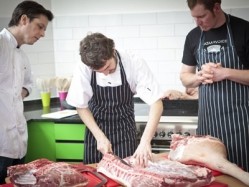Nose-to-tail cookery and thoughtful meat use crucial for sustainability

The points were made at a nose-to-tail workshop held by Ethical Eats, the network for restaurants and caterers interested in sustainability, created by Sustain.
The event at Central Street Cookery School, near Old Street in London, was held to bring chefs and the meat industry together and promote waste reduction. Chef Alan Stewart led the workshop as he butchered a pig and described how he used the whole of the animal at his Manson restaurant.
The Gloucester Old Spot, provided by Richard Woodhouse from meat wholesalers Billfields of London, was used to show how each part of the carcass could be used and, in the process, cut costs and produce more diverse food. The event's guests were encouraged to discuss the provenance of meat and the benefits of using less typical cuts of meat.
Cooking offal
Duncan O'Brien, project officer at Sustain, told BigHospitality the event came about as a result of a Twitter debate on meat use which revealed many people in the food industry remained unaware of issues in the meat industry. The event was used to bring the two sides together while highlighting the environmental and health benefits of sustainability and eating less meat.
O'Brien said the issue of wasting less of an animal could be helped by having a more diverse menu.
"In the UK we've broadly trended towards more homogenous food over the last 20 or 30 years, we're trying to change that. If you have a menu that stays the same throughout the year it's unlikely you'll be using local and seasonal ingredients. Holding classes on things like cooking with offal makes people more aware of diversity in food preparation," he said.
Financial sense
Describing how he used the whole animal in his restaurant, Stewart said it was not just sustainable and good for the environment but made financial sense too. He argued buying a whole carcass enabled chefs to 'offer value to the customer' as buying a whole animal and using less well-known cuts could bring down the cost of a part of the animal already used on the menu.
Using offal was about more than just being blatant about its place in a dish. Stewart added. It could be used to distill flavour or create stock while the tail or rib cage could be used in sauces.
Cristiano Meneghin of Tongue 'n' Cheek, which provides meals using lesser-known cuts of meat at eat.st in London's King's Cross, said products like ox tongue occasionally made the public scared but could be used in burgers cheaply and to add taste.
Other issues raised at the event included the point that offal was more highly prized in other cultures but could be used to create unique dishes. Using more of the animal was a way of showing creativity, educating customers, developing butchery skills and building relationships with suppliers, attendees to the event argued.
A follow-up nose-to-tail fortnight is planned where London restaurants will be invited to add nose-to-tail specials to their menu promoted through the Ethical Eats network and London Food Link.















